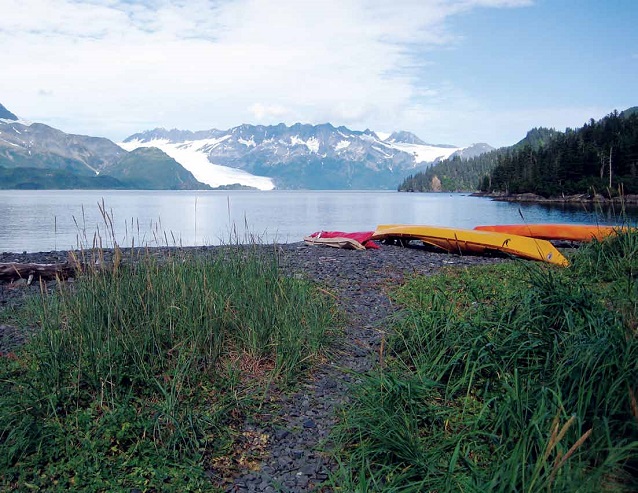
NPS photograph
The coastal campsite experience
A night on the coast; it comes with spectacular water-front views, peace and quiet, and fresh air. Camping on the Kenai Fjords National Park (NP) coast is an amazing experience that draws hundreds of visitors to the park each summer.
Although the park is comprised of over 500 miles of spectacular coastline, most of the coast is characterized by steep, rocky headlands, cliffs, and boulder beaches that are virtually inaccessible to boaters and campers. As a result, opportunities for camping are limited to only about 80 sheltered sand/gravel beaches scattered along the length of the park from Nuka Bay in the southwest to Resurrection Bay in the northeast (Figure 2). About half of these potential campsites are located in the more remote southern end of the park, the outer coast, and Nuka Bay, and consequently receive very little overnight use. As a result, nearly all backcountry camping is concentrated at about 40 beaches located in Aialik Bay and North-western Lagoon. These same areas also contain sensitive cultural, archeological, and natural resources, including salmon spawning streams, ground-nesting marine birds, coastal sedge meadows and, bald eagle nests.
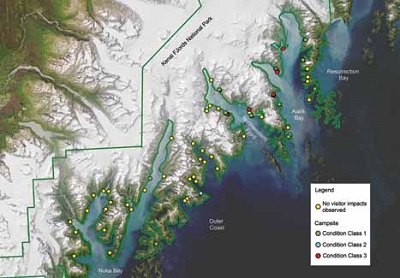
Management need
Kenai Fjords has a history of periodic campsite surveys that dates to at least 1988 (Tetreau 2004). This work revealed impacts to park resources such as fire rings, charred wood, cut stumps, root exposure, vegetation trampling, trash, human waste, soil erosion, campsite proliferation, increased human-wildlife interactions, and social trails. Trends of increasing resource impacts raised concerns of altered ecologic condition, impacts to visitors’ wilderness experience, and for visitor safety (Figure 3). From 1988 to 2004 various monitoring methods were used to document condi-tions, and a review highlighted the need to improve the consistency, accuracy, and efficiency of field assessment and data analysis (Tetreau 2004, Monz et al. 2006).
Former Kenai Fjords NP ecologist Meg Hahr turned the recommendations of Tetreau (2004) and Monz et al. (2006) into a collaborative effort that integrates science, mapping technologies, management, and visitor perspec-tives to inform and provide adaptive recommendations to park managers. Needed management information included details about condition of landing beaches, trends in visitor (camping) impacts at known campsites, size and number of tent sites, use and condition of bear-resistant food storage lockers, and other visitor impacts. Since the park does not require permits for camping or most other forms of visitor use, managers needed a clear understanding of changes in the spatial distribution of preferred camping locations in a landscape where tidewater glaciers can retreat at rates approaching 246 feet (75 m) per year (Giffen et al. 2009), vegetation succession is equally as rapid, and shoreline or beach morphology changes are poorly understood due to the interaction of tectonic forces with sea level rise (Pendleton et al. 2006).
In 2007, Hahr led a rapid assessment of campsite impacts at 55 landing beaches between Nuka and Aialik Bays (Figure 2). From 2008 to 2010, Dr. Christopher Monz, a recreation ecologist from Utah State University, spent several weeks in the park testing, refining, and implementing campsite monitoring protocols. During this same time NPS Alaska Regional Office Geographic Information System (GIS) staff were enlisted to develop Geographic Positioning System (GPS) data collection tools, protocols, and databases for managing the collected data in a streamlined manner (Figure 4). Park staff involvement included resource, visitor and resource protection specialists to ensure diverse management perspectives.
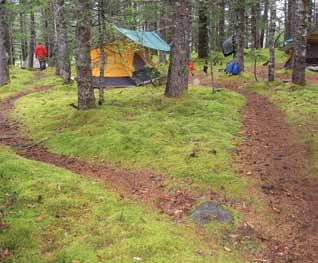
NPS photograph
Science
Backcountry camping has the potential to affect resource conditions both intensively at the on-site scale and extensively due to site expansion and proliferation (Leung and Marion 1999, Cole 2004). Campsites are im-portant from a managerial and visitor perspective as they serve as destinations and focal points for visitor activities, thereby creating areas of concentrated use. Although numerous studies of campsites in parks and protected areas have examined the degree to which visitor use can affect change on site conditions (e.g., Frissell 1978, Cole 1983, Marion 1995), studies examining change over long periods are few (e.g., Cole et al. 2008, Twardock et al. 2010).
Campsite assessment methodologies have a long history of use in parks and protected areas, dating back to the work of Sumner (1942) and Frissell and Duncan (1965), to the more recent contributions of Cole (1989), Marion (1995) and Newman et al. (2006). While campsite studies are commonplace in the lower 48 states, relatively little work has been accomplished in Alaska environments with the exception of long-term studies conducted in Prince William Sound (Twardock et al. 2010, Monz and Twardock 2010). Lake Clark National Park and Preserve has maintained backcountry campsite inventories as early as the 1980s, but protocols and quantitative measurements have not been standardized.
Based on reviews of the historical campsite work in Kenai Fjords NP and consultation with park staff, the development of new assessment protocols was initiated with four overall goals. First, the protocols needed to be more clear in definition of terms and descriptions of ratings-based procedures. Second, campsites needed established reference points that could easily be relocated. Relocation of sites had been problematic by the lack of established reference points and consequently site area remeasurement was not possible. Third, efficiently planning field work needed to be addressed in terms of staff time during an assessment trip and integrating program work into park operations. Last, protocols must withstand a changing field staff without sacrificing accuracy and repeatability.
We were able to accommodate these concerns in sev-eral ways. We relied on contemporary campsite protocols developed in intervening years (e.g., Marion 1995) and on the extensive work conducted in Prince William Sound (Twardock et al. 2010) to make wholesale revisions to the methods. Improvements occurred to condition class rat-ings criteria and definitions, use of radial transect meth-ods for termination of site areas, and to ratings-based systems for visual estimation of various impacts. Next, we conducted two extensive assessments with a large team that brought researchers, field staff and resource mangers together in the field to refine and troubleshoot the meth-ods. Last, we incorporated the best available camera and GPS technology to streamline and enforce consistency in data collection, site relocation, and data processing.
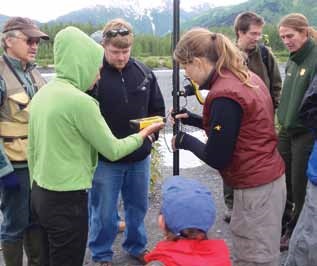
NPS photograph
Technology
The technological aspects of establishing protocols were daunting. We developed standardized, electronic data templates to ensure consistent data collection and integration with GPS data. Collection of photographic documentation, a critical component for comparisons with previous work, was also standardized, and its collection was integrated with GPS data (Figure 5). A geo-database compatible with GIS was developed, serving as a shell to organize and manage this diverse information. One noteworthy benefit of integrating data collection into protocols is that multiple components of collected data are linked in GIS, in database applications, and in reporting tools. For example, electronic campsite maps coded by condition class and linked with site photographs are easily generated.
Limited GPS reception in the steep-sided fjords of the park, wet conditions necessitating waterproof electronics, and the need for tools that can be used by staff with a range of technical knowledge were challenges encountered. Having the technical experts experience first-hand the field data collection and data management challenges proved essential to bridging these challenges.
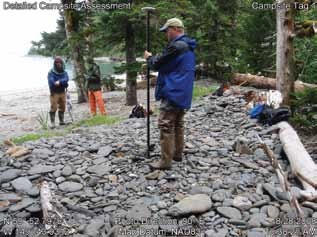
NPS photographs
Applications of campsite assessments
One of the opportunities that came with revising campsite monitoring methods has been to encourage park staff participation in monitoring efforts. The monitoring protocols provide a structure and clarity of purpose to field efforts, providing field staff with specific monitoring objectives integrated into other responsibili-ties while still allowing for opportunities to interact with visitors. Additional opportunities include invasive plant and coastal mortality (avian influenza and sea otters) surveys that can occur alongside campsite assessments.
Direct improvements to campsite management were the intent of and are an outcome of this process. One example is the bear-resistant food storage lockers, which are one of the main tools the park has to promote or direct use to selected areas. The systematic visits and documentation of campsite and food storage lockers identified high visitor use areas with missing or sub-standard lockers. Since implementing updated campsite monitoring methods, Kenai Fjords National Park has been able to rapidly respond to changes in visitor use patterns, with data in hand to support management directed changes to campsite amenities.
Acknowledgements
This work would not have occurred without the tireless efforts of Meg Hahr (see dedication in this issue) and was made possible in part by grants from the National Park Service and National Park Foundation. We are also grateful for the support of NPS Alaska Region GIS Team member Greg Daniels for his efforts in developing GIS, GPS, and geodatabase tools. Kenai Fjords National Park staff Janette Chiron, Shelley Hall, and Christina Kriedeman and Utah State University doctoral student Kelly Goonan were instrumental in helping to start this monitoring. We would also like to thank the many field and office staff and crew for their assistance.
References
Cole, D.N. 1983. Monitoring the condition of wilderness campsites. USDA Forest Service Research Paper INT-302. Intermountain Forest and Range Experiment Station. Ogden, UT.
Cole, D.N. 1989. Wilderness campsite monitoring methods: A sourcebook. USDA Forest Service General Technical Report INT-259. Intermountain Research Station. Ogden, UT.
Cole, D.N. 2004. Impacts of hiking and camping on soils and vegetation. In Environmental Impacts of Ecotourism edited by R. Buckley. CABI. Wallingford, U.K. Pp. 41-60.
Cole, D.N., P. Foti, and M. Brown. 2008. Twenty years of change on campsites in the backcountry of Grand Canyon National Park. Environmental Management 41: 959-970.
Frissell, S.S. 1978. Judging recreational impacts on wilderness campsites. Journal of Forestry 76: 481-483.
Frissell, S.S., and D.P. Duncan. 1965. Campsite preference and deterioration in the Quetico-Superior canoe country. Journal of Forestry 65: 256-260.
Giffen, B.A., D.K. Hall, and J.Y.L. Chien. 2009. Alaska: Glaciers of Kenai Fjords National Park and Katmai National Park and Preserve. In Global Land Ice Measurements from Space (GLIMS) Chapter 12. Draft report.
Leung, Y.-F., and J.L. Marion. 1999. Characterizing backcountry camping impacts in Great Smokey Mountains National Park, USA. Journal of Environmental Management 57: 193-203.
Marion, J.L. 1995. Capabilities and management utility of recreation impact monitoring programs. Environmental Management 19: 763-771.
Monz, C.A, I. Martin, M. Tetreau, and S. Hall. 2006. Visitor Use and Impact Monitoring in Kenai Fjords National Park: A summary of scoping results and future monitoring needs. Kenai Fjords National Park, Alaska. NPS Unpublished Report.
Monz, C.A., and P. Twardock. 2010. A classification of campsites in Prince William Sound, Alaska, USA. Journal of Environmental Management 91 (7): 1566-1572.
Newman, P.N., C.A. Monz, Y.-F. Leung, and D.M. Theobold. 2006. New methodological considerations for assessing campsite conditions. George Wright Forum 23 (2): 28-35.
Pendleton, E.A., E.R. Thieler, and S.J. Williams. 2006. Relative Coastal Change-Potential Assessment of Kenai Fjords National Park. U.S. Geological Survey Open-File Report 2004-1373.
Sumner, E.L. 1942. The biology of wilderness protection. Sierra Club Bulletin 27 (8): 14-22.
Tetreau, M. 2004. Backcountry campsite surveys in Aialik Bay, Resurrection Bay and Northwestern Fjord - Kenai Fjords National Park, Alaska. NPS Unpublished Report.
Twardock, P., C.A. Monz, M. Smith, and S. Colt. 2010. Long-term changes in resource conditions on backcountry campsites in Prince William Sound, Alaska, USA. Northwest Science 84 (3): 223-232.
Last updated: December 27, 2016
